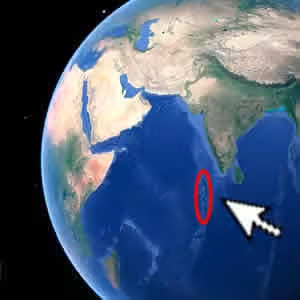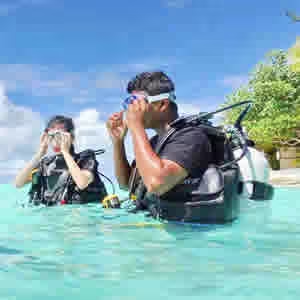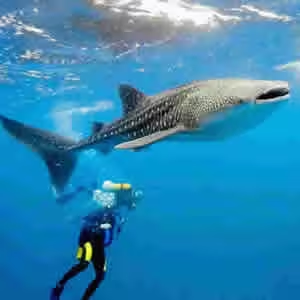Sharks in Maldives
Maldives Scuba Diving Guide
Updated August, 2022
The world travelers and divers, dreaming to discover the white sand beaches and clear azure water of the Maldives flock to the island nation attracted by the fantastic marine life that the Indian ocean has to offer. One of the most eligible experiences divers and snorkelers crave is the chance to meet face-to-face.with sharks.
The Maldives is a premier destination for diving and is home to stunning fish life. Lured by bountiful coral reefs and a rich marine life, there are more than 20 different species of sharks in the Maldives including whale shark but there are only a dozen or so you will see while diving or snorkeling on the reefs. Swimming with sharks in the Maldives isn’t as terrifying as you might expect. The sharks in Maldives are harmless, and if you see one, it may come to check you out, but will likely swim off. For the entire existence of tourism in the Maldives, the only case of shark attacks on human was recorded.
The best way to swim with sharks in the Maldives is on a shark safari or private excursion. Experienced divers will take you to remote sites where you can snorkel or scuba dive in the company of whale sharks as they glide peacefully alongside you.
Are there dangerous sharks in Maldives? Is it safe to swim with whale shark? Read this page to learn everything you want to know about sharks in the Maldives.
Whitetip reef shark
- English Name: Whitetip reef shark
- Family: Carcharhinidae
- Maldivian Name: Olhufathi miyaru
- Order: Carcharhiniformes
- Size: Common to 1.6 m; max, 2.1 m
Distinctive Characters: Body relatively slender. Snout broad and short - shorter than width of mouth. Three pointed teeth. Base of first dorsal fin closer to pelvics than pectorals. Second dorsal fin large, its
height over half that of first dorsal fin.
Colour: Greyish brown above, pale below. White tips to first dorsal and upper caudal lobe.
Habitat and Biology: The whitetip reef shark is one of the three most common sharks inhabiting the reefs of the Maldives, the other two being the blacktip reef shark and the grey reef shark. Occurs in coastal clear waters, usually in and around coral reefs at depths down toat least 30 m. Feeds on wide variety of reeffishes, but also cephalopods and large crustaceans. Viviparous, with 1 to 5 young per litter (commonly 2 or 3).
Distribution: Indo-Pacific and Eastern Pacific.
Human interactions: Unlike its Oceanic cousin, the white tip reef shark is more harmless and is seldom aggressive unless provoked. They are rarely aggressive towards humans, though they may investigate swimmers closely. However, spear fishers are at risk of being bitten by one attempting to steal their catch.
Remarks: Triaenodon ohesus is one of the most common of Maldivian sharks. Previously recorded under the family Hemigaleidae. The whitetip sharks are commonly seen by divers, resting on bottom. They are slow moving but are active throughout the day and night. These sharks spend much of their time resting inside caves during the day. An individual shark may rest inside the same cave for months to years. Unlike other requiem sharks, which rely on ram ventilation and must constantly swim to breathe, this shark can pump water over its gills and lie still on the bottom. Most active at night whitetip reef sharks emerge to hunt bony fishes, crustaceans, and octopus in groups, their elongate bodies allowing them to force their way into crevices and holes to extract hidden prey.
Blacktip reef shark
- English Name: Blacktip shark
- Family: CARCHARHINIDAE
- Local Name: Thun hima miyaru
- Order: Carcharhiniformes
- Size: Common to 1.5 m; max. 2.5 m
Distinctive Characters: A medium-sized, fairly stocky shark. Long snout, its length about equal to mouth width. Upper and lower teeth nearly symmetrical and similar, with erect narrow cusps and serrated edges. First dorsal fin pointed and with origin roughly level with pectoral insertions.
Colour: Grey with brassy sheen; pale below. Black on tips to dorsal fins, paired fins, anal fin, lower caudal lobe and on leading edges of caudal fin.
Habitat and Biology: Blacktip reef sharks are some of the commonest shark species in the Maldives. Occurs in coastal as well as offshore surface waters. Fast moving, sometimes leaping out of water. Feeds mainly on schooling fishes, occasionally on crustaceans and cephalopods. Viviparous, with a yolk-sac placenta: number of young per litter 1-10, commonly 4 -7.
Distribution: World-wide in tropical and subtropical waters.
Human interactions: Under most circumstances, the blacktip reef shark has a timid demeanor and is easily frightened away by the divers and snorkelers. The blacktip reef shark has also been known to become aggressive in the presence of bait, and may pose a threat while attempting to steal the catches of spear fishers.
Grey Reef Shark
- English Name: Grey reef shark
- Family: CARCHARHINIDAE
- Maldivian Name: Vahboa miyaru
- Order: Carcharhiniformes
- Size: Common to 1.6 m; max. 1.9 m
Distinctive Characters: A moderate-sized fairly stocky shark with large eyes. Snout broadly rounded. Upper teeth serrate, narrowly triangular. Anterior nasal flaps very low. This species can be distinguished from similar species by the plain or white-tipped first dorsal fin, the dark tips on the other fins, the broad, black rear margin on the tail fin, and the lack of a ridge between the dorsal fins, 24-28 teeth injaws. Most species are less than 2 m (6.6 ft) long.
Colour: Grey above, pale below. Trailing edge of caudal fin broadly blackish. Upper part of trailing edge of first dorsal fin narrowly whitish (in Indian Ocean individuals).
Habitat and Biology: Mostly grey reef sharks have a home range on a specific area of the reef or on upper part of outerreef slopes to depths of about 100 m or more, to which they continually come back. Grey reef sharks are fast-swimming, agile predators that feed mainly on bony fishes, occasionally on cephalopods and crustaceans. However, they are social rather than territorial. During the day, these sharks often form groups of five to 20 individuals near coral reef drop-offs, splitting up in the evening as the sharks begin to hunt. Like other members of its family, the grey reef shark is viviparous, with a yolk-sac placenta; every other year the number of young per litter 1 to 6.
Distribution: Indo-Pacific.
Human interactions: Grey reef sharks are often curious about divers when they first enter the water and may approach quite closely, though they lose interest on repeat dives. They can become dangerous in the presence of food, and tend to be more aggressive if encountered in open water rather than on the reef. This species will also attack if pursued or cornered, and divers should immediately retreat (slowly and always facing the shark) if it begins to perform a threat display. Photographing should not be attempted, as the flash from a camera is known to have incited at least one attack.
Remarks: Carcharhinus annblyrhynchos is one of the commonest reef shark in Maldives, and it is this species that is normally seen by divers at shark feeding stations. This, combined with small differences in colouration and dentition, has led some to suggest that they might be two seperate species. Their aggressive demeanor enables them to dominate many other shark species on the reef, despite their moderate size.
Tawny nurse shark
- English Name: Tawny nurse shark
- Family: GINGLYMOSTOMATIDAE
- Maldivian Name: Nidhan miyaru
- Order: Orectolohiformes
- Size: Max. just over 3 m
Distinctive Characters: Body without ridges. Caudal fin about 30% of total length. Pectoral. dorsal and anal fins with angular apices. Teeth compressed. with moderate central cusp and 4—6 smaller cusps on sides. The maximum recorded length of the tawny nurse shark is 3.2 m (10 ft).
Colour: Brown, from tan to dark grey —brown. Paler below.
Habitat and Biology: Occurs in shallow waters from the intertidal zone to a depth above 70 m. Demersal on coral and rocky reefs, in lagoons and on sand flats. Feeds on a variety of bottom invertebrates, corals, and small fishes. The tawny nurse shark may be one of the few fishes specializing in preying on octopus. Mainly nocturnal, often resting in caves or under overhangs by day. Ovoviviparous: number of young at least 4 per uterus.
Distribution: Indo-Pacific.
Human interactions: Encounters with tawny nurse sharks underwater indicate a more docile demeanor than the similar nurse shark; usually divers are able to approach the sharks closely and even touch and play with them without incident. However, this species has been infrequently provoked into biting, and merits respect due to its strength, small but sharp teeth, and extremely powerful jaws. Tawny nurse sharks are favored attractions for ecotourist divers and snorkelers off the Maldives.
Thresher shark
- English Name: Thresher shark
- Family: ALOPIIDAE
- Local Name: Kandi miyaru
- Order: Lamniformes
- Size: Max. 5.5 m or more
Distinctive Characters: A large shark, with enormous upper caudal lobe, at least as long as rest of shark. No grooves on nape; profile of head not indented. Eyes moderately large and extending onto dorsal surface of head. First dorsal fin much larger than second, and located just behind pectoral fin insertions.
Colour: Dark above and abruptly white below, White area extends over pectoral fin bases.
Habitatand Biology: Coastal over the continental and insular shelves and epipelagic far from land. Young often close inshore. Feeds mainly on schooling fishes, but also on cephalopods and pelagic crustaceans. Ovoviviparous and apparently a uterine canibal, number of young 2-4 per litter.
Distribution: Circumglobal in warm seas.
Remarks: Random encounters with divers take place in Maldivian waters and it were registered to the Fuvahmulah only.
Shortfin mako
- English Name: Shortfin mako
- Family: LAMNIDAE
- LocalName: Woshimas miyaru
- Order: Lamniformes
- Size: Common to 2 m; max.4.5m
Distinctive Characters: Body moderately slender. Conical pointed snout. Caudal fin lunate. Caudal peduncle extremely broad and well developed. Pectoral fins distinctly shorter than head.
Colour: Dark blue-grey above, white below.
Habitat and Biology: Oceanic and coastal, usually in surface waters down to 152 m. Feeds on schooling fish, using its slender and sharply pointed teeth. Also attacks sharks and billfishes. Ovoviviparous without yolk-sac placenta, number of pups per litter 2 to 16.
Distribution: Temperateand tropical waters.
Human interactions: This species will not generally attack humans and does not seem to treat them as prey. Divers who have encountered shortfin mako note, prior to an attack, they swim in a figure-eight pattern and approach with mouths open. Most modern attacks involving shortfin mako sharks are considered to have been provoked due to harassment or the shark being caught on a fishing line.
Remarks: Isurus oxyrinchus is an extremelyfast and powerful shark, as its noticeably broad caudal peduncle suggests. It is apotentially dangerous shark. The longfin mako (I. paucus Guitar Manday, 1966) is very similar in appearance but has a blunter snout and pectoral fins longer than the head; it probably occurs in Maldivian waters but has not yet been recorded.
Scalloped Hammerhead shark
:max_bytes(150000):strip_icc():format(webp)/scalloped-hammerhead-shark-598966361-57255c885f9b589e34dedc9f.jpg)
- English Name: Scalloped hammerhead
- Family: CARCHARHINIDAE
- Maldivian Name: Kaaligandu miyaru
- Order: Carcharhiniformes
- Size: Max. 4.2 m
Distinctive Characters: Head hammer-shaped. Broad ‘hammer’ head, with median and lateral indentations. First dorsal origin slightly behind pectoral insertion. Posterior margin of eye roughly level with front of mouth, Margin of pelvic fins nearly straight.
Colour: Grey brown above, white below.
Habitat and Biology: Offshore, oceanic, but comes closer to continental edge and occasionally enters enclosed bays. Young form large true schools but adults mainly solitary or in pairs. Feeds on pelagic fishes, crustaceans and cephalopods. Viviparous; number of young 15 to 31 per litter.
Distribution: Circumtropical.
Remarks: There are possibly three species of hammerheads which occur in the Maldives. But Sphyrna lewini is the only one that has been definitely recorded and confirmed from here to date. Large schools observed by divers near A. Rasdhoo and a few other sites. Great Hammerhead Shark has been spotted around Vakarufalhi, Maldives. Potentially dangerous to people.
Tiger shark

- English Name: Tiger shark
- Family: CARCHARHINIDAE
- Local Name: Femunu miyaru
- Order: Carcharhiniformes
- Size: Max. 7.4 m or more
Distinctive Characters: Body large and fairly stout. Short, blunt snout. Foreparts stout, but hindparts more slender, Low keel on either side of caudal peduncle. Distinctive teeth (see illustration). Upper labial furrows very long extending to front of eyes. Spiracle present.
Colour: Grey. Dark spots and stripes on sides which fade with growth.
Habitat and Biology: Occurs in inshore, as well as offshore waters, near the surfaceand bottom. Avoracious indiscriminate predator feeding on all kinds of fish, marine mammals, turtles, sea birds, sea snakes, cephalopods, molluscs and crustaceans, as well as carrion and garbage. Ovoviviparous; size of litters very large, 10 to 82, This species may mature at between 4 to 6 years old.
Distribution: Circumtropical.
Remarks: Ga/eocerdo cuvier is one of the most dangerous sharks. It attacks divers, swimmers and even boats. Certainly the tiger shark has the worst reputation as a man eater amongst tropical sharks.
Where to see: For divers who specifically seek adrenaline-rush adventures, one destination is recently gaining popularity as the ideal place to regularly spot for diving with sea tigers in the Maldives – Fuvahmulah.
Zebra shark

- English Name: Zebra shark, Variegated shark
- Family: STEGOSTOMATIDAE
- Local Name: Faana niiyaru
- Order: Orectolobitormes
- Size: To 3.5 m or more
Distinctive Characters: Long caudal fin, about half the total length. Small barbels on either side of small mouth. First dorsal set well back and much larger than second. Prominent ridges on sides of body.
Colour: Adults pale brown with dark spots. Juveniles dark brown with vertical yellow stripes.
Habitat and Biology: Found on coral reefs. A rather sluggish shark. Strictly nocturnal; feeds on molluscs, sea snakes, crustaceans and fish. Oviparous.
Distribution: Indo-West Pacific.
Remarks: Stegostoma lasciatum is not a very common shark in Maldives. but is occasionally seen resting on the bottom by divers. This shark is unaggressive when approached under water.
Guitar shark
- English Name: The guitarfish or ray
- Family: Rhinobatidae, of rays
- Size: To 3 m and more
Distinctive Characters: The guitarfish are known for an elongated body with a flattened head and trunk and small ray like wings. Guitarfish’s have a body form intermediate between those of sharks and rays. Guitarfish have a body form intermediate between those of sharks and rays. The tail has a typical shark-like form, but in many species, the head has a triangular, or guitar-like shape, rather than the disc-shape formed by fusion with the pectoral fins found in other rays
Habitat and Biology: Guitarfish are bottom feeders that bury themselves in mud or sand and eat worms, crabs, and clams. Some can tolerate salt, fresh, and brackish water. They generally live close to the beach/coastline. They often travel in large schools. Guitarfish are ovoviviparous; the embryo matures inside an egg inside the mother until it is ready to hatch. This is typical of rays.
Distribution: The combined range of the various species is tropical, subtropical and temperate waters worldwide.
Silky shark

- English Name: Silky shark
- Family: CARCHARHINIDAE
- Local Name: Oivaali miyaru, Ainu miyaru
- Order: Carcharhiniformes
- Size: Max. 3.3 m
Distinctive Characters: A large, relatively slender shark. Snout moderately long and pointed. Origin of first dorsal fin behind the rear of pectorals. Second dorsal low with long posterior extension, Pectoral long and pointed. Ridge between dorsals.
Colour: Grey, pale below.
Habitat and Biology: Inhabits oceanic waters near and beyond continental slopes, but also found in coastal waters. Usually near the surface but also found at depths to 500 m. Feeds mainly on fishes, squids and octopods. Viviparous with a yolk-sac placenta; 2-4 young per litter.
Distribution: Circumtropical.
Remarks: Carcharhinus falciformis is the commonest oceanic shark in Maldivian waters. The Dhivehi name ‘Oivaali miyaru refers to the habit of small individuals of swimming beneath drifting objects. The name ‘Ainu miyaru’refers to its habit of swimming with tuna schools.
Blue shark

- English Name: Blue shark
- Family: CARCHARHINIDAE
- Local Name: Andhun miyaru
- Order: Carcharhiniformes
- Size: Max. 3.8 m
Distinctive Characters: A slender shark with long snout and long pointed pectorals. No spiracles. Base of first dorsal closer to pelvic than pectoral origins. Weak keel on either sides of caudal peduncle.
Colour: Deep blue above, pale below.
Habitat and Biology: Oceanic, epipelagic, from the surface to at least 220 m depth. It prefers relatively cool water at 7°Cto 16°C,but can tolerate warmer waters. Feeds on bony fishes, small sharks, squids, pelagic crustaceans and occasionally sea birds and carrion. Viviparous, with a yolk-sac placenta; number of young 4 to 135 per litter.
Distribution: Circumglobal in temperate and tropical waters.
Human interactions: Blue sharks rarely bite divers
Remarks: Prionace glauca is probably the widest ranging chondrichthyian, but it is not very common in the Maldives. It is known to undertake long distance of migrations and show some degree of sexual segregation. 95% of blue sharks in Maldivian waters are males. A dangerous shark with several attacks on people and boats on record.
Silvertip shark

English Name: Silvertip shark
Family: CARCHARHINIDAE
Local Name: Kattafulhi miyaru
Order: Carcharhiniformes
Size: Max, 3 m
Distinctive Characters: Snout moderatelylong and broadly rounded. Upperteeth broadly triangular. Second dorsal fin with a base less than twice height. Ridge between dorsal fins.
Colour: Grey above, pale below. First dorsal, pectoral, pelvic and caudal fins with extremely conspicuous white tips and posterior margins.
Habitat and Biology: Occurs inshore and offshore from the surface to a depth of 800 m. Feeds on both bottom and pelagic fish, including rays and cephalopods. Viviparous, with a yolk-sac placenta; number of young 1 to 11 per litter, often 5 to 6.
Distribution: Tropical lndo-Pacific.
Human interactions: Inquisitive and bold, especially in the presence of food, the silvertip shark is regarded as potentially dangerous to humans. This species has also been known to circle or pursue divers.
Remarks: Carcharhinus albimarginatus is said to be very aggressive and individuals often have evidence of combat scars. This shark is potentially dangerous to people. Rarely seen by divers in the Maldives, although there have been regular sightings at two sites in An Atoll.
Whale shark
- English Name: Whale shark
- Family: RHINCODONTIDAE
- Local Name: Fehurihi
- Order: Orectolobiformes
- Size: Rare above 12 m
Distinctive Characters: With its huge size and distinctive spotting. whale shark cannot be confused with any other species. Very wide, nearly terminal mouth with numerous minute teeth. Very broad head.
Colour: Dark above with numerous narrow whitish bars and! rows of spots. Pale below.
Habitat and Biology: A pelagic filter feeder, occurring singly or in small schook, often near the surface. Feeds mainly on plankton. sometimes on small pelagic crustaceans or small schooling fishes.
Distribution: Circumtropical.
Remarks: Rhincodon typus is the largest living fish. Despite its large size, it is not a diangerous species. It is sometimes seen by divers, normally during south-west monsoon off the east coast, and during the north-east monsoon off the west coast. No specimens have been collected, or likely to he collected, but this species have been seen by Fisheries staff occasionally. The whale shark being rare and endangered, is a protected species in the Maldives.
Best places to see: The following are the 10 best whale shark locations in the Maldives along with an indication of what is the best time to go.

Beach or Water Villa?
Maldives - a name that became synonymous with honeymooners' paradise in the tourism world, has slowly revamped to cater to the needs of families visiting
Read More
Best Maldives Resort Offers & Packages
Find out more about the most unparalleled Maldives hotel deals and special rates, when Book Direct your next beach holiday
Read More
Maldives Hotel Reviews
Some of the best hotels and resorts in the Maldives are already included in this list, and the good part of them offers the best prices. We will constantly add new hotels
Read More
10 Exclusive Resorts in Maldives
The Maldives is paradise destination that should be on the bucket list of every discerning travelers. There's a special breed of hotels there that cater to the most tasteful of luxury travelers Read More

The Maldives’ Hottest Luxury Hotel Openings for 2023
Here are just 10 of the amazing new resorts in the Maldives that are set to welcome guests Read More

10 Most Affordable Water Villas
While it may never be cheap to visit thу Maldives, fortunately there are still some chic and relatively affordable overwater villas you can stay. Read more

Maldives Luxury Guide
Here's the best of Maldives for luxury travellers. We've compiled the finest recommendations of places to stay, ranging from the most celebrated five-star resorts to luxurious private islands Read More

Maldives Romantic Guide
The ultimate ‘flop and drop' and honeymoon destination, the Maldives is the playground for the most amazing and finest utilization of each second of this extremely valuable and hopeful time with each other in tota Read More

Maldives Budget Guide
Budget travellers choose Maldives as their destination of choice thanks to the variety of affordable stays Read More

Maldives Family Guide
Maldives - a name that became synonymous with honeymooners' paradise in the tourism world, has slowly Read More

Maldives Diving Guide
The life of these paradise islands below the Indian Ocean's level is the main draw attracting thousands of divers Read More


























